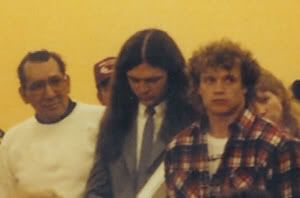The Televised Candidates
"Comedians have often suggested that Ronald Reagan’s immense popularity might have been helped by television-induced confusion. But I would like to make the case that this was concretely true, and that it’s not so funny.
"Ronald Reagan spent his adult life being an image, sometimes fictional – as when performing in films – and sometimes in that odd semi-reality that performers obtain in commercials. For his career combined film acting and, perhaps more important, spokesperson roles for General Electric Company advertising.
"Because of his background, Reagan handled television as president with astonishing skill and power. He understood, as no one did before, that on television, style supercedes content: The way you behave and look is more important than what you say or do. He knew that complexity and historical perspective do not come across on TV as well as simplicity, bald assertions, the heavy use of symbolic content, and the appeal to formulaic values, deeply imbedded in Americans by previous decades of television and film: Good vs. Evil, America vs. The Enemy, Revere the Flag. ( Reagan’s protégé, George Bush, also learned these lessons; he was elected in 1988 because of his embrace of TV symbolism – the flag, the pledge of allegiance, black rapists – mixed with spots about Dukakis and pollution, which turned out to be lies.)
"Reagan’s most remarkable achievement was to incorporate in his own persona an amazing set of archetypes from the popular movies of the 1940s and 1950s. In the real role of president, Ronald Reagan re-created a set of images that had been reinforced by standard story lines since World War II; he was making real what was previously just imagery held in the minds of the population.
"Ronald Reagan became the World War II hero, standing tall. He became the admiral on the bridge of the ships, taking on the hated Nazis and Japanese, though it became the Commies and Iranians. He was the western hero, slow to anger, but push him too far and he became fierce in his response. He was not a Rambo, a contemporary unfeeling slaughterer. He had morals. He was John Wayne. He was Gary Cooper in High Noon."
--In the Absence of the Sacred; Jerry Mander; Sierra Club Books; 1991; pages 90-91.
Presidential campaigns, including the primary season, are often decided by the public’s perceptions of each candidate’s communication skills. In 1960, the televised Kennedy vs. Nixon debate was a classic example: those who watched it on TV believed JFK won, while those listening to radio favored Nixon.
The republican party recognized that the public could be manipulated by the use of TV imagery, which is what Mander described so accurately in the sub-chapter "The Televison President." They had Reagan front for outrageous lies: the attack on Grenada became a "rescue," and the MX missiles were "peacekeepers." Mander notes that Reagan and Bush1 learned from Orwell to have a frequent "Two Minutes Hate" of shifting Goldsteins: Khomeni, Khadafy, Ortega, Willie Horton, Noriega, and Saddam Hussein.
There could be no more bizarre example of manipulating the screen than in the 2004 campaign: George W. Bush was presented as a patriotic military leader, while John Kerry was portrayed as a shady figure who betrayed the uniform.
Still, it would be an error to assume that because the republican party has stolen something from the democrats, that the stolen good is irreparably contaminated. Like the lead-in to Helter Skelter on U2’s "Rattle & Hum" says, "This is a song that Charles Manson stole from the Beatles … we’re stealing it back."
It is a good thing for the democrats to promote Barack Obama as being in the image of JFK; of John Edwards as this generation’s RFK; and Hillary Clinton as our Eleanor Roosevelt. Are the comparisons exact? Of course not. But one similarity is that the same negative things the nay-sayers respond with are much like the negative things people said about JFK, RFK, and Eleanor Roosevelt.
It is interesting to note that there is greater difficulty in projecting the Eleanor image, because she is not embedded in the collective TV consciousness. People who have learned about her in modern times are those who read, and reading creates a different type of mental activity than watching TV. When we look at how image played in modern times, Reagan convinced those who preferred to watch the movie rather than read that book, while Carter appealed to literate people.
Today we have the computer/ internet. This form of communication combines many of the best qualities of both the book and the TV screen. During the 2008 elections, we can be sure that the republican party will make every attempt to use it against the democratic party. We need to use every tool available to us in the contest for image.


1 Comments:
Sorry it took so long to get back to your blog.
As usual, it was well worth the time and you touched upon an interesting point that I think I'll spend some more time exploring. The point? Hillary and Elanor...fascinating possibilities to ponder there.
As usual, wishing you all the best.
ewagner from DU
Post a Comment
<< Home